News from RSPB Scotland
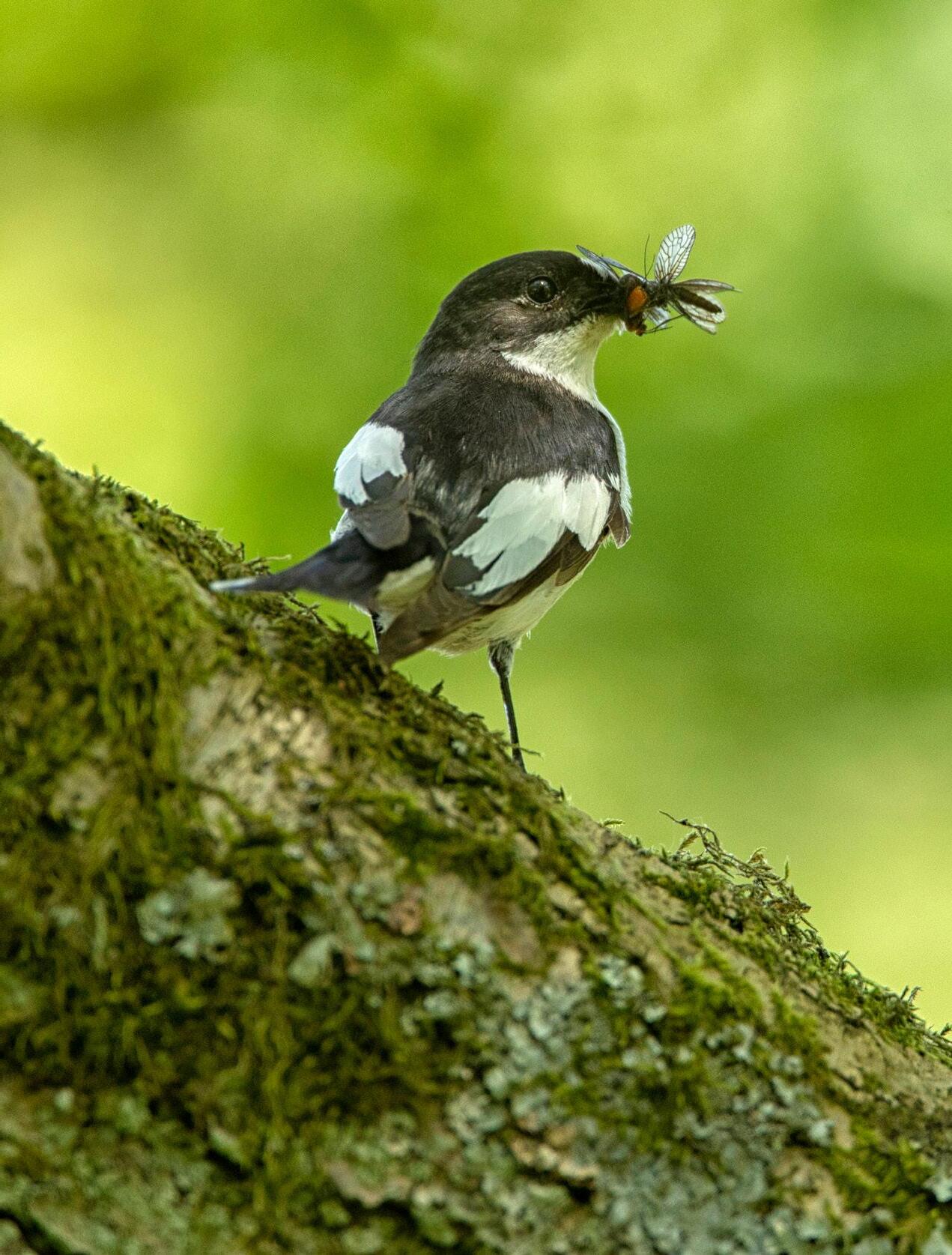

News from RSPB Scotland

We’re

Spring is a welcome time when we look forward to a refresh in nature. While it is a season for optimism, as we continue to face a nature and climate emergency we are beginning to see signs of spring arriving earlier. These changes could put wildlife under greater pressure.
The new Natural Environment Bill should create a framework for ambitious nature recovery targets. This is a critical opportunity for the Scottish Government to embed nature in the actions they take, and we will be watching closely.
In the previous issue, we shared an update on Coul Links. Following a public inquiry, the fate of this site is now in the hands of Scottish Ministers, and we are urging them to refuse this damaging proposal.
To be inspired to speak up for nature, it is important to feel connected to wildlife. One simple way to discover nature in spring is to listen out for the Dawn Chorus. This breathtaking experience can be enjoyed close to home or on an adventure to a nature reserve (p3).
There is exciting nature conservation taking place across Scotland and, as a member, you are already making a huge difference. I hope you enjoy celebrating these stories that we’re delighted to share in this issue.

Anne McCall Director, RSPB Scotland
Follow Anne on @stranyannie
a
about bringing back the
After 21 years working as RSPB Mull Officer, Dave Sexton retired in 2024. We asked him for some highlights from his career overseeing the reintroduction of one of Scotland’s most iconic species, the White-tailed Eagle, as we celebrate the 50th anniversary of the return of these birds.
What is your best eagle memory? It has to be my first sighting of an adult White-tailed Eagle while I was on holiday on Mull in 1980. It’s what triggered my passion for this bird and everything that’s happened since. I couldn’t believe my eyes!
How did you get your job with the RSPB? After that first sighting I wrote endlessly to the RSPB Species Protection Department, begging them to give me the job of protecting the eagles after they’d been released from Rum. Eventually they gave in! When I got the job offer I thought, ‘Now I’m going to actually get paid to watch Whitetailed Eagles… on Mull!’
What was your favourite part of the role? Watching young eagles fledge from the nest and take to the wing for the first time. It makes all the worry, blood, sweat and tears of the breeding season worthwhile. I saw them getting better at flying every day and it just gladdens the heart.
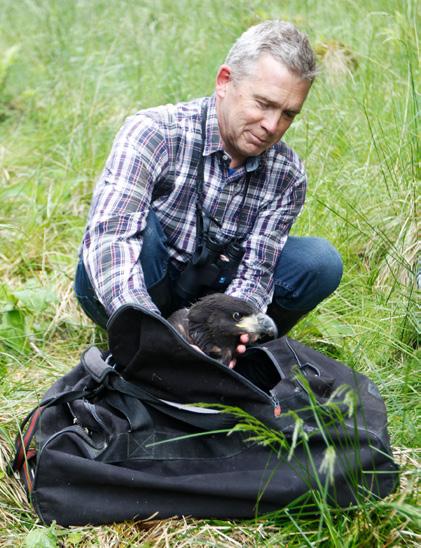
Tell us your best eagle fact I thought Skye, the oldest White-tailed Eagle in the UK, was doing well at age 30. But at a Sea Eagle conference in Croatia last year, I learned there’s a female still breeding in Denmark which was ringed as a chick in Germany in 1985, making her 40 years old. Incredible! And it makes me wonder, could that first chick on Mull in 1985 still be out there somewhere….?
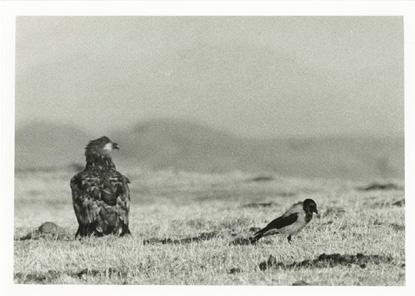


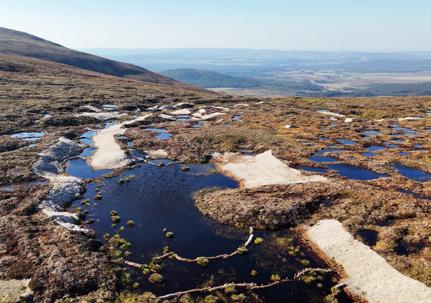
Peatlands are one of the most effective natural solutions in the fight against climate change. Healthy peatlands also provide habitats for wildlife and benefit people, by reducing flood risk, filtering water, and even helping reduce the risk of wildfires. Sadly, 75% of Scotland’s peatlands are degraded in some way.
RSPB Scotland is leading efforts to restore these vital ecosystems. This year, over 500 hectares of peatland have been restored across our nature reserves including Forsinard, Abernethy, Airds Moss, Birsay Moors, Yell
and Loch Gruinart. This work will improve conditions for species and climate change resilience, and reduce carbon loss.
Through efforts to restore this precious habitat across Scotland, we are aiming to deliver benefits for nature, climate and people. These projects are supported by Scottish Government’s Peatland ACTION Fund delivered in partnership with NatureScot and Cairngorms National Park Authority through Cairngorms Peatland ACTION, Suntory Global Spirits and Omaze.





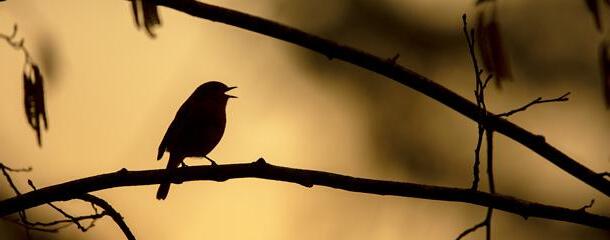
The arrival of spring brings with it the magic of the dawn chorus. Have a sneak peek at what you might hear across our nature reserves this season.
Loch Lomond
Wonderful woodland species belt out their tunes. Listen for the onomatopoeic call of the Chiffchaff.
Lochwinnoch
Soak up the sounds of wetland birds as they add their rich and varied calls to the chorus.

Loch Garten
On a wander through the peaceful pine forest enjoy the calls of Goldcrests, Chaffinches and perhaps a Crested Tit.
Loch Leven
Enjoy a cacophony of sound as the sun rises with the stunning songs of warblers, thrushes and more filling the air.
Plan your dawn chorus adventure: rspb.org.uk/reserves
Hundreds of volunteers across Scotland are helping the RSPB to protect habitats and save species. From surveying in Shetland to giving nature a home in Glasgow there are so many ways that you can donate time to support nature. How to help Volunteer with us!
“I moved to a new area and knew that I wanted to find other nature lovers. I was recommended to get in touch with my RSPB Local Group and have really enjoyed getting involved as a volunteer.”
- Highland Local Group volunteer
To find out more about the volunteering opportunities available, scan the code or get in touch with us: scotvolunteers@rspb.org.uk

Over five years, the LIFE 100% for Nature project has tried ambitious new ways to make Scotland the best it can be for wildlife – and celebrated remarkable success
11
RSPB Scotland nature reserves involved
12 ,565 7
sheep weighings, helping farmers reduce medication use and costs, increasing food sources for Choughs
designated species have benefited
97%
reduction in herbicide use at Nigg Bay and Udale Bay, benefiting Bar-tailed Godwits
212ha
of Caledonian Pinewood and coastal marsh grazed, helping rare species like Capercaillie and Natterjack Toads
Life 100% For Nature is a project funded by the LIFE programme of the European Union, NatureScot and other supporters. To find out more, scan the code or visit bit.ly/RSPBLife100ForNature



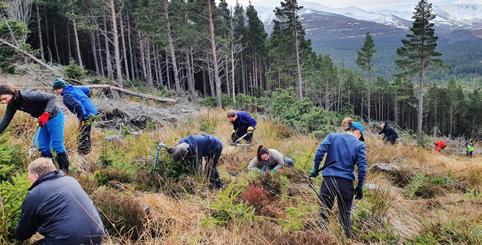
Over the last five years, the Cairngorms Capercaillie Project partnership, of which RSPB Scotland was a partner, worked together to build a brighter future for one of our most endangered species.
Led by the Cairngorms National Park Authority, the project celebrated successes including restoring thousands of hectares of habitat, reducing disturbance, collecting genetic material for research, investing in the local economy, raising awareness and engaging communities.
What we have learned during this time is now helping to support the

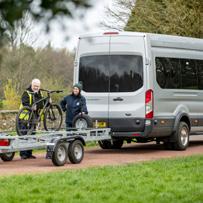
Climate FORTH’s Inner Forth bike bus is back! This free service between Alloa and the Forth Bridges runs every Sunday from 20 April to the end of October. The bus makes it easy to explore the Inner Forth, with space for 12 bikes, and bus stops close to the Round the Inner Forth cycle route. It’s free to use thanks to lottery players and funding from The National Lottery Heritage Fund and the Crown Estate via Fife Council. innerforthlandscape.co.uk



A habitat improvement volunteer day
future of conservation for this species

For the first time in 400 years there is a Beaver lodge (above) and dam at RSPB Scotland Insh Marshes nature reserve. After their release last year, it is great to see them making themselves at home. Our neighbours were delighted to spot the signs of an additional lodge and dam created on their land. These structures improve water quality, create new habitats for other animals and reduce the risk of flooding downstream by slowing water flow. Work on bringing Beavers back to the Cairngorms National Park has been led by the Park Authority, working closely with partners, land managers and local communities.
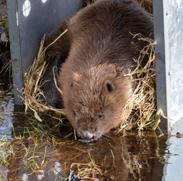
The landscape is always transforming at this nature reserve. With new meadows and wetland work, there is something to discover even if you have been before

he wetlands are the star of the show and a must-see during your visit. Wander through the bright summer meadows, step into the Marsh Hide and take a moment to slow down and soak in the sights and sounds of the varied nature around you.
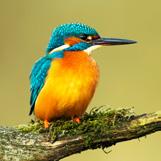
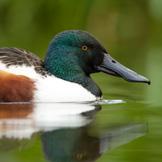
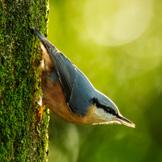
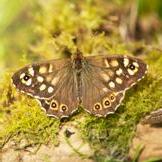
There is a whole new area of wetland here with spectacular views of wading birds and ducks. This is a top spot to enjoy one of the stand-out species at Baron’s Haugh, the Kingfisher, as you can get a special close-up view of this stunning species.
Spend some time strolling along the river, find a quiet spot, and, with a bit of patience, you may be lucky enough to spot Otters. While not so rare to see, an equally special experience is capturing a glance of a Roe Deer before it bounds away, white tail bobbing into the trees.
There are a few walking route options around Baron’s Haugh and the neighbouring Dalzell Estate, depending on how long you would like to explore and what you hope to see. Remember to wear sturdy
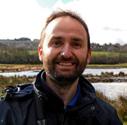
Our people
David Anderson is Site Manager for Baron’s Haugh and Forth nature reserves. He’s worked for RSPB Scotland for 15 years, starting as a visitor engagement officer at Loch Garten Nature Centre in 2009.
RSPB Baron’s Haugh
Seasonal highlights
Over the past few years, fields have been transformed into vibrant wildflower meadows, which burst into life in spring. As they come into full bloom, visitors can walk footpaths through Oxeye Daisies, Yellow Rattle and Tufted Vetch, and enjoy the flit and hum of butterflies and bees. rspb.org.uk/BaronsHaugh

shoes, bring water and any food you might need, as well as insect repellent. There’s also a calendar of events at the nature reserve – keep an eye out for them as they book out quickly.
What are your favourite species to see at Baron’s Haugh?
Little Egrets, or occasionally even Great White Egrets. They seem so exotic and different from what you expect to see here in Scotland. They’re such stunning and elegant birds, even with them becoming more common it still gives a thrill of excitement when you spot one on the nature reserve.
Scotland is home to some of Europe’s biggest and most biodiverse patches of temperate rainforest. It’s under threat, but we can save it
Dotted around the far west of Scotland, you’ll find a very special type of woodland. Mantled in the greenest of greens, these are rainforests – not tropical, but temperate: coolish, wet and teeming with life. These ancient woods are humid and grow largely undisturbed, which is perfect for mosses, liverworts and lichens. These crowd every tree trunk, branch, rock and wall, and hundreds of different species can be found here, many of which are rare elsewhere, making these woods globally important. Scotland’s rainforest is incredibly rich in a wide range of wildlife, including threatened birds like Wood Warbler and Pied Flycatcher; mammals like Pine Marten and Red Squirrel; and insects such as Chequered Skipper butterfly, which is seen in few other places.
An industrial legacy
The woodlands of Scotland’s rainforest are made up of a mix of native trees, though in some areas, one species will dominate. A particularly rare rainforest woodland is called Atlantic Hazelwood, and unusual lichens grow here, including the White Script lichen that’s found nowhere else in the world. Some of these Hazel woods are thought to be up to 9,000 years old.
But few rainforest woodlands are entirely ‘natural’. People have influenced how most of them have formed. Oak trees are very common in Scotland’s rainforest because, in the past, Oak wood was in high demand for making charcoal, and the bark for tanning leather. The people involved in these industries managed the trees, which probably helped the woodlands survive.
Rainforest under threat
These industries are long gone, and our ancient rainforest is facing new threats. Scotland holds some of the biggest and most biodiverse patches of temperate rainforest in all of Europe, but only about 30,000 hectares remain (an area about the size of Edinburgh). What remains is also spread out and fragmented, making it vulnerable to events like fires, and preventing the spread of rare species.
However, the biggest pressures on Scotland’s rainforest are from over-browsing by unsustainably high numbers of deer, and the spread of a really invasive type of rhododendron. These non-native plants are now thought to be growing in around 40% of Scotland’s rainforest and are spreading fast, threatening what’s left of this precious habitat.


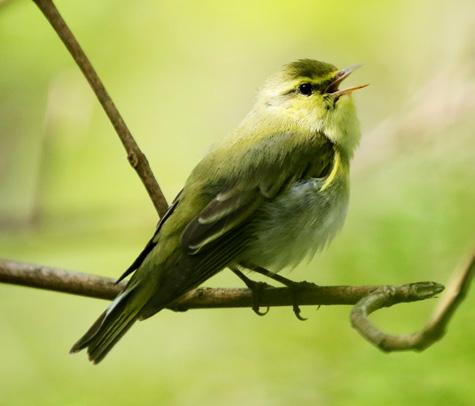

Lichens are a mix of fungi and either algae or a type of bacteria. The fungus offers protection, while the other part produces food through photosynthesis.

1% of the Earth’s land surface has the right conditions for temperate rainforests to form.
types of lichen can be found in Scotland’s rainforest.

Filmy ferns are tiny ferns that mostly grow in tropical rainforests. However, two different species grow in Scotland’s rainforest: Wilson’s Filmy Fern and Tunbridge Filmy Fern.

Bryophyte is a collective term for mosses, liverworts and hornworts. They’re our oldest land plants, and much older than flowering plants.
Find out more
To learn more, scan the code or go to savingscotlands rainforest.org.uk



Rainforest restorers, assemble!
Saving Scotland’s rainforest for the future is a huge task, and to be effective, it has to be tackled across huge areas of land over many years. That means a collaboration of local communities and landowners, with dedicated funding and a long-term commitment from government agencies. To make this happen, 24 organisations, including RSPB Scotland, have come together to form the Alliance for Scotland’s Rainforest (ASR). This partnership has adopted nine rainforest projects that cover almost 300,000 hectares. We’re running one of these projects, Saving Morvern’s Rainforest. Through this, a small, dedicated team, is attempting to remove all invasive rhododendron from the whole Morvern peninsula, with the commitment to maintain these woods in the future.
A new tree nursery has also been set up through the project, using seeds collected from local rainforest woodlands. One of these is RSPB Glencripesdale, on Morvern, an incredibly rich rainforest nature reserve that’s crammed with rare wildlife.
Because of its location, Glencripesdale is tricky to access. But we manage three more nature reserves that contain rainforest habitats: Loch Lomond, Inversnaid and Glenborrodale. Both Inversnaid and Loch Lomond sit within the Loch Lomond and Trossachs National Park and are very accessible. Decades of disturbance from people and animals mean there are fewer rainforest species found here, but work is underway to help these woodlands recover. Glenborrodale, which lies just along the coast from Strontian, is a more remote rainforest habitat, and is a great place to see some of the rich biodiversity these woodlands have to offer.
Support for rainforest restoration
Our rainforest restoration work has been made possible by the Scottish Government’s Nature Restoration Fund (NRF), managed by NatureScot. Additional funding has also been received from the Garfield Weston Foundation and private charitable trusts. Your membership also provides crucial support for our work.

2.
3.
4.
5.

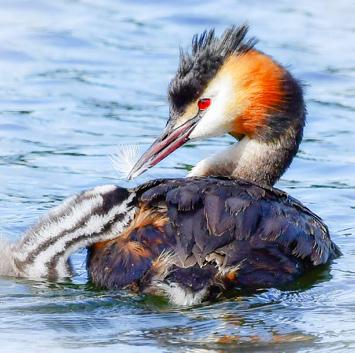
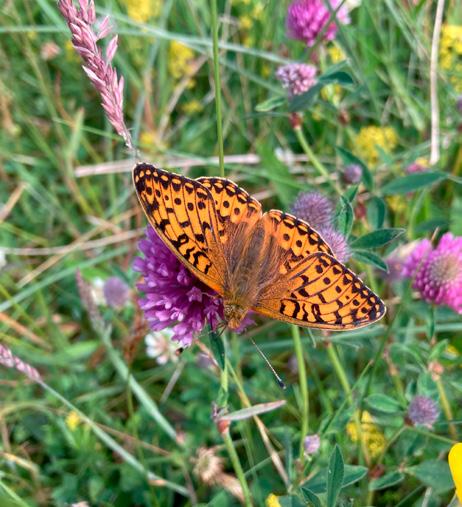

With our podcast: bit.ly/rspb-scotland- podcast
With our YouTube playlist: bit.ly/rspb-scotland-playlist
At our blog: rspb.org.uk/ scottish-nature-notes
RSPB Scotland Headquarters 2 Lochside View, Edinburgh Park, Edinburgh EH12 9DH 0131 317 4100 rspb.scotland@rspb.org.uk
North Scotland offices Etive House, Beechwood Park, Inverness IV2 3BW 01463 715000 nsro@rspb.org.uk Suite 2.25, 2nd Floor, H1 Building, Hill of Rubislaw, Anderson Drive, AB15 6BL 01224 624824 nsro@rspb.org.uk South Scotland office 10 Park Quadrant, Glasgow G3 6BS 0141 331 0993 glasgow@rspb.org.uk Contact
RSPB Scotland has a network of enthusiastic local groups. Find one near you: rspb.org.uk/localgroups